2018 VOLVO V90 CROSS COUNTRY warning
[x] Cancel search: warningPage 318 of 662
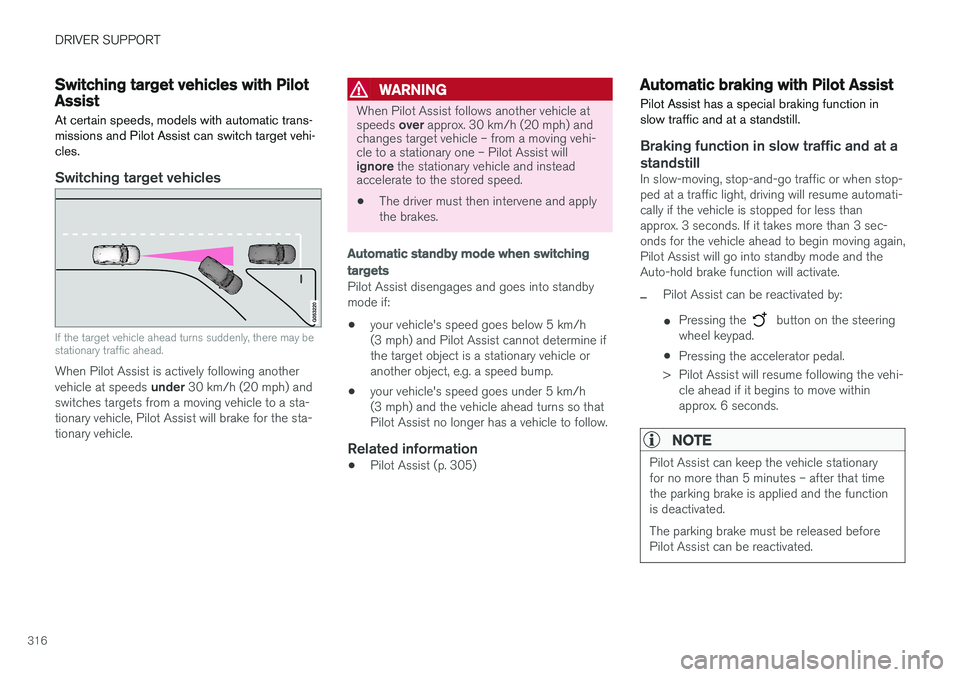
DRIVER SUPPORT
316
Switching target vehicles with PilotAssist
At certain speeds, models with automatic trans-
missions and Pilot Assist can switch target vehi-cles.
Switching target vehicles
If the target vehicle ahead turns suddenly, there may be stationary traffic ahead.
When Pilot Assist is actively following another vehicle at speeds under 30 km/h (20 mph) and
switches targets from a moving vehicle to a sta-
tionary vehicle, Pilot Assist will brake for the sta-tionary vehicle.
WARNING
When Pilot Assist follows another vehicle at speeds over approx. 30 km/h (20 mph) and
changes target vehicle – from a moving vehi- cle to a stationary one – Pilot Assist will ignore the stationary vehicle and instead
accelerate to the stored speed.
• The driver must then intervene and apply the brakes.
Automatic standby mode when switching
targets
Pilot Assist disengages and goes into standby mode if:
• your vehicle's speed goes below 5 km/h(3 mph) and Pilot Assist cannot determine ifthe target object is a stationary vehicle oranother object, e.g. a speed bump.
• your vehicle's speed goes under 5 km/h(3 mph) and the vehicle ahead turns so thatPilot Assist no longer has a vehicle to follow.
Related information
•Pilot Assist (p. 305)
Automatic braking with Pilot Assist
Pilot Assist has a special braking function in slow traffic and at a standstill.
Braking function in slow traffic and at a standstill
In slow-moving, stop-and-go traffic or when stop- ped at a traffic light, driving will resume automati-cally if the vehicle is stopped for less thanapprox. 3 seconds. If it takes more than 3 sec-onds for the vehicle ahead to begin moving again,Pilot Assist will go into standby mode and theAuto-hold brake function will activate.
–Pilot Assist can be reactivated by:
• Pressing the
button on the steering
wheel keypad.
• Pressing the accelerator pedal.
> Pilot Assist will resume following the vehi- cle ahead if it begins to move within approx. 6 seconds.
NOTE
Pilot Assist can keep the vehicle stationary for no more than 5 minutes – after that timethe parking brake is applied and the functionis deactivated. The parking brake must be released before Pilot Assist can be reactivated.
Page 319 of 662
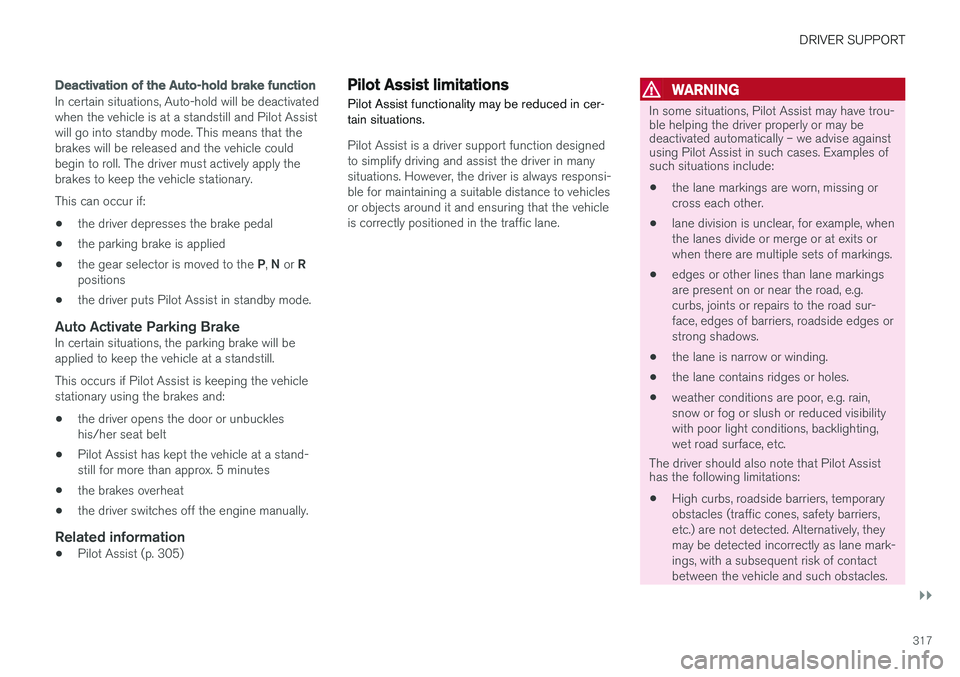
DRIVER SUPPORT
}}}}
317
Deactivation of the Auto-hold brake function
In certain situations, Auto-hold will be deactivated when the vehicle is at a standstill and Pilot Assistwill go into standby mode. This means that thebrakes will be released and the vehicle couldbegin to roll. The driver must actively apply thebrakes to keep the vehicle stationary. This can occur if:
• the driver depresses the brake pedal
• the parking brake is applied
• the gear selector is moved to the
P, N or R
positions
• the driver puts Pilot Assist in standby mode.
Auto Activate Parking BrakeIn certain situations, the parking brake will be applied to keep the vehicle at a standstill. This occurs if Pilot Assist is keeping the vehicle stationary using the brakes and:
• the driver opens the door or unbuckleshis/her seat belt
• Pilot Assist has kept the vehicle at a stand-still for more than approx. 5 minutes
• the brakes overheat
• the driver switches off the engine manually.
Related information
•Pilot Assist (p. 305)
Pilot Assist limitations
Pilot Assist functionality may be reduced in cer- tain situations.
Pilot Assist is a driver support function designed to simplify driving and assist the driver in manysituations. However, the driver is always responsi-ble for maintaining a suitable distance to vehiclesor objects around it and ensuring that the vehicleis correctly positioned in the traffic lane.
WARNING
In some situations, Pilot Assist may have trou- ble helping the driver properly or may bedeactivated automatically – we advise againstusing Pilot Assist in such cases. Examples ofsuch situations include:
• the lane markings are worn, missing or cross each other.
• lane division is unclear, for example, whenthe lanes divide or merge or at exits orwhen there are multiple sets of markings.
• edges or other lines than lane markingsare present on or near the road, e.g.curbs, joints or repairs to the road sur-face, edges of barriers, roadside edges orstrong shadows.
• the lane is narrow or winding.
• the lane contains ridges or holes.
• weather conditions are poor, e.g. rain,snow or fog or slush or reduced visibilitywith poor light conditions, backlighting,wet road surface, etc.
The driver should also note that Pilot Assist has the following limitations: • High curbs, roadside barriers, temporary obstacles (traffic cones, safety barriers,etc.) are not detected. Alternatively, theymay be detected incorrectly as lane mark-ings, with a subsequent risk of contactbetween the vehicle and such obstacles.
Page 332 of 662
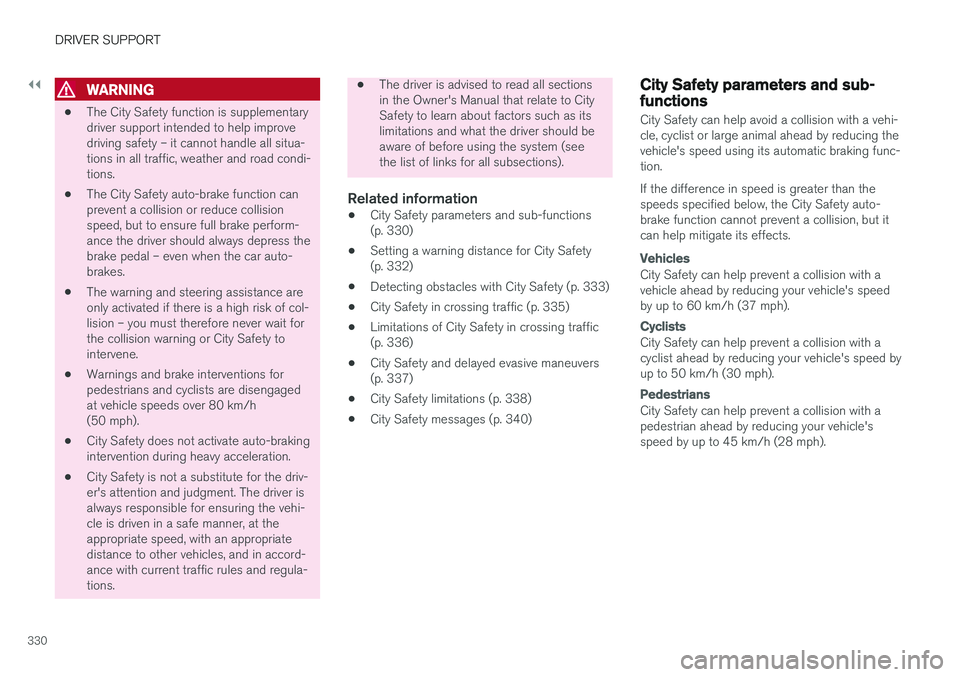
||
DRIVER SUPPORT
330
WARNING
•The City Safety function is supplementary driver support intended to help improvedriving safety – it cannot handle all situa-tions in all traffic, weather and road condi-tions.
• The City Safety auto-brake function canprevent a collision or reduce collisionspeed, but to ensure full brake perform-ance the driver should always depress thebrake pedal – even when the car auto-brakes.
• The warning and steering assistance areonly activated if there is a high risk of col-lision – you must therefore never wait forthe collision warning or City Safety tointervene.
• Warnings and brake interventions forpedestrians and cyclists are disengagedat vehicle speeds over 80 km/h(50 mph).
• City Safety does not activate auto-brakingintervention during heavy acceleration.
• City Safety is not a substitute for the driv-er's attention and judgment. The driver isalways responsible for ensuring the vehi-cle is driven in a safe manner, at theappropriate speed, with an appropriatedistance to other vehicles, and in accord-ance with current traffic rules and regula-tions.
• The driver is advised to read all sections in the Owner's Manual that relate to CitySafety to learn about factors such as itslimitations and what the driver should beaware of before using the system (seethe list of links for all subsections).
Related information
•City Safety parameters and sub-functions(p. 330)
• Setting a warning distance for City Safety(p. 332)
• Detecting obstacles with City Safety (p. 333)
• City Safety in crossing traffic (p. 335)
• Limitations of City Safety in crossing traffic(p. 336)
• City Safety and delayed evasive maneuvers(p. 337)
• City Safety limitations (p. 338)
• City Safety messages (p. 340)
City Safety parameters and sub-functions
City Safety can help avoid a collision with a vehi- cle, cyclist or large animal ahead by reducing thevehicle's speed using its automatic braking func-tion. If the difference in speed is greater than the speeds specified below, the City Safety auto-brake function cannot prevent a collision, but itcan help mitigate its effects.
Vehicles
City Safety can help prevent a collision with a vehicle ahead by reducing your vehicle's speedby up to 60 km/h (37 mph).
Cyclists
City Safety can help prevent a collision with a cyclist ahead by reducing your vehicle's speed byup to 50 km/h (30 mph).
Pedestrians
City Safety can help prevent a collision with a pedestrian ahead by reducing your vehicle'sspeed by up to 45 km/h (28 mph).
Page 333 of 662
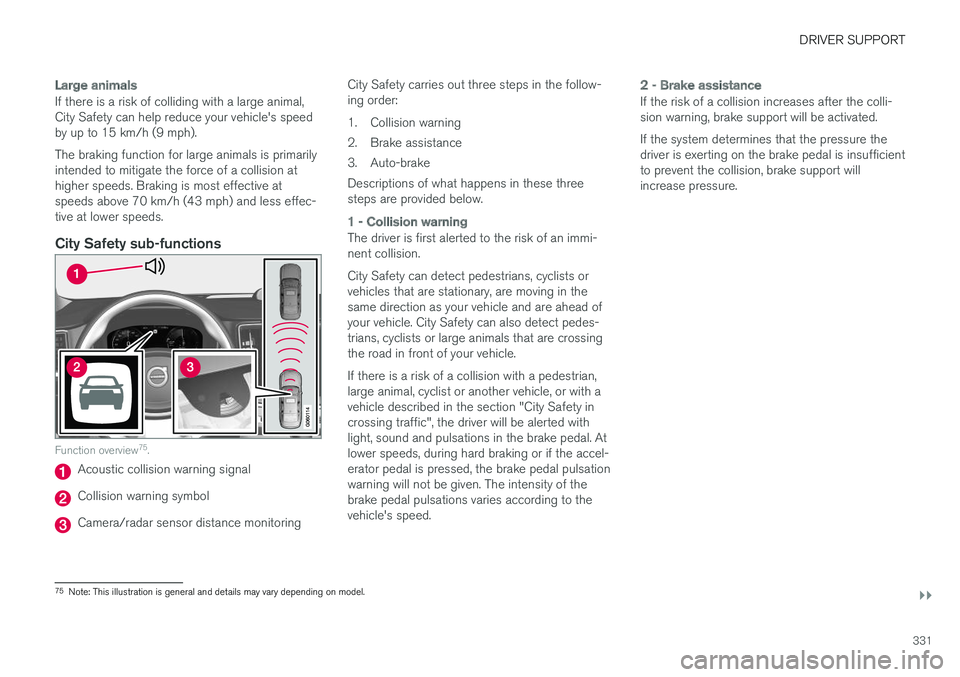
DRIVER SUPPORT
}}
331
Large animals
If there is a risk of colliding with a large animal, City Safety can help reduce your vehicle's speedby up to 15 km/h (9 mph). The braking function for large animals is primarily intended to mitigate the force of a collision athigher speeds. Braking is most effective atspeeds above 70 km/h (43 mph) and less effec-tive at lower speeds.
City Safety sub-functions
Function overview75
.
Acoustic collision warning signal
Collision warning symbol
Camera/radar sensor distance monitoring City Safety carries out three steps in the follow- ing order:
1. Collision warning
2. Brake assistance
3. Auto-brakeDescriptions of what happens in these three steps are provided below.
1 - Collision warning
The driver is first alerted to the risk of an immi- nent collision. City Safety can detect pedestrians, cyclists or vehicles that are stationary, are moving in thesame direction as your vehicle and are ahead ofyour vehicle. City Safety can also detect pedes-trians, cyclists or large animals that are crossingthe road in front of your vehicle. If there is a risk of a collision with a pedestrian, large animal, cyclist or another vehicle, or with avehicle described in the section "City Safety incrossing traffic", the driver will be alerted withlight, sound and pulsations in the brake pedal. Atlower speeds, during hard braking or if the accel-erator pedal is pressed, the brake pedal pulsationwarning will not be given. The intensity of thebrake pedal pulsations varies according to thevehicle's speed.
2 - Brake assistance
If the risk of a collision increases after the colli- sion warning, brake support will be activated. If the system determines that the pressure the driver is exerting on the brake pedal is insufficientto prevent the collision, brake support willincrease pressure.
75
Note: This illustration is general and details may vary depending on model.
Page 334 of 662
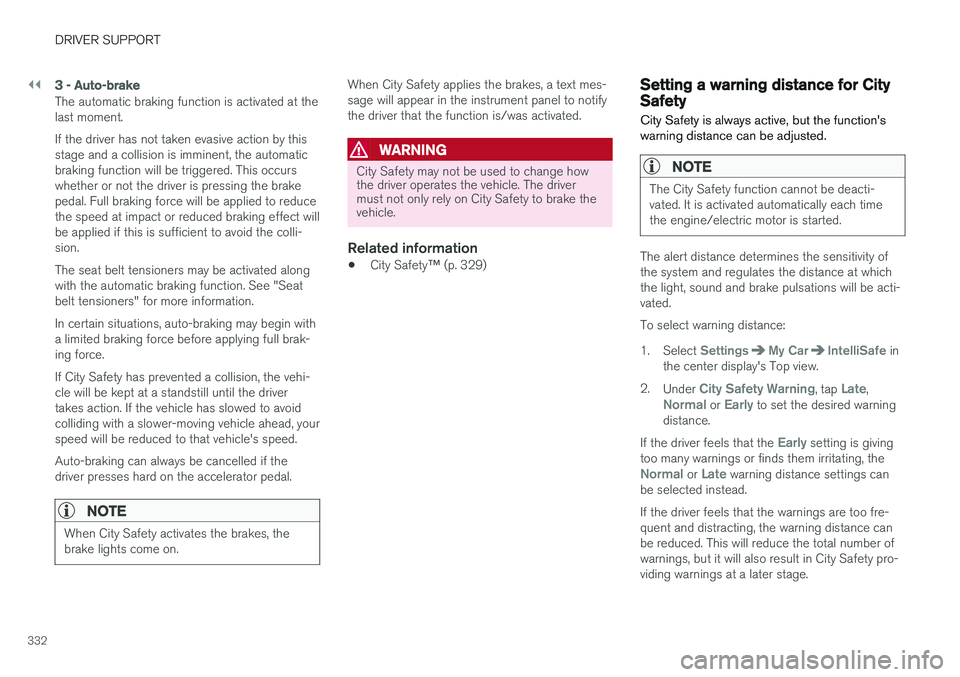
||
DRIVER SUPPORT
332
3 - Auto-brake
The automatic braking function is activated at the last moment. If the driver has not taken evasive action by this stage and a collision is imminent, the automaticbraking function will be triggered. This occurswhether or not the driver is pressing the brakepedal. Full braking force will be applied to reducethe speed at impact or reduced braking effect willbe applied if this is sufficient to avoid the colli-sion. The seat belt tensioners may be activated along with the automatic braking function. See "Seatbelt tensioners" for more information. In certain situations, auto-braking may begin with a limited braking force before applying full brak- ing force. If City Safety has prevented a collision, the vehi- cle will be kept at a standstill until the drivertakes action. If the vehicle has slowed to avoidcolliding with a slower-moving vehicle ahead, yourspeed will be reduced to that vehicle's speed. Auto-braking can always be cancelled if the driver presses hard on the accelerator pedal.
NOTE
When City Safety activates the brakes, the brake lights come on.
When City Safety applies the brakes, a text mes- sage will appear in the instrument panel to notifythe driver that the function is/was activated.
WARNING
City Safety may not be used to change how the driver operates the vehicle. The drivermust not only rely on City Safety to brake thevehicle.
Related information
•City Safety
™ (p. 329)
Setting a warning distance for CitySafety
City Safety is always active, but the function's warning distance can be adjusted.
NOTE
The City Safety function cannot be deacti- vated. It is activated automatically each timethe engine/electric motor is started.
The alert distance determines the sensitivity of the system and regulates the distance at whichthe light, sound and brake pulsations will be acti-vated. To select warning distance:
1. Select
SettingsMy CarIntelliSafe in
the center display's Top view.
2. Under
City Safety Warning, tap Late,Normal or Early to set the desired warning
distance.
If the driver feels that the
Early setting is giving
too many warnings or finds them irritating, the
Normal or Late warning distance settings can
be selected instead. If the driver feels that the warnings are too fre- quent and distracting, the warning distance canbe reduced. This will reduce the total number ofwarnings, but it will also result in City Safety pro-viding warnings at a later stage.
Page 335 of 662
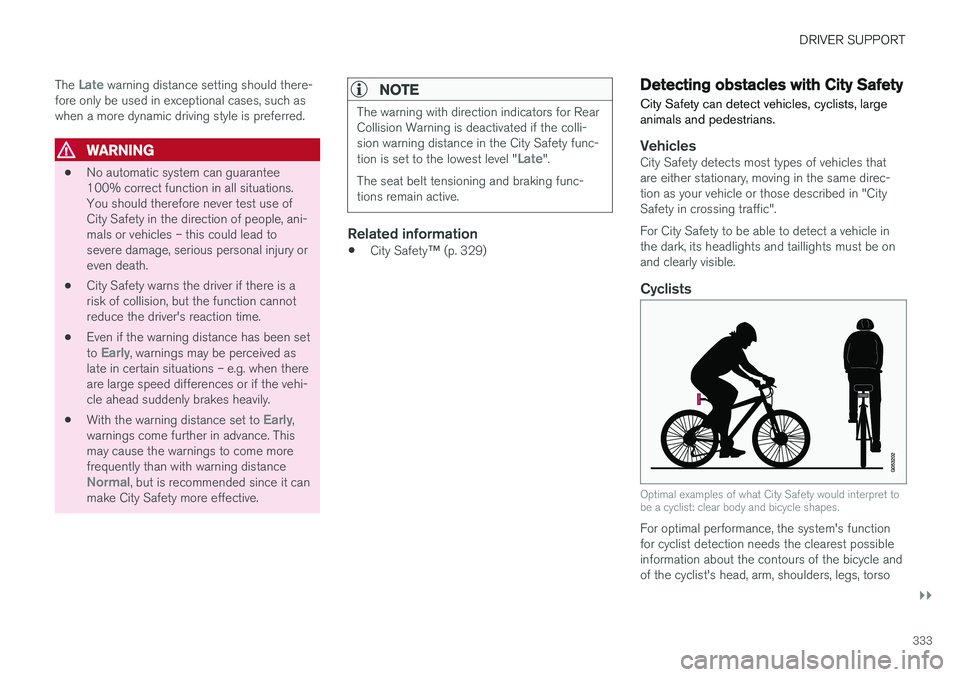
DRIVER SUPPORT
}}
333
The
Late warning distance setting should there-
fore only be used in exceptional cases, such as when a more dynamic driving style is preferred.
WARNING
• No automatic system can guarantee 100% correct function in all situations.You should therefore never test use ofCity Safety in the direction of people, ani-mals or vehicles – this could lead tosevere damage, serious personal injury oreven death.
• City Safety warns the driver if there is arisk of collision, but the function cannotreduce the driver's reaction time.
• Even if the warning distance has been set to
Early, warnings may be perceived as
late in certain situations – e.g. when there are large speed differences or if the vehi-cle ahead suddenly brakes heavily.
• With the warning distance set to
Early,
warnings come further in advance. This may cause the warnings to come morefrequently than with warning distance
Normal, but is recommended since it can
make City Safety more effective.
NOTE
The warning with direction indicators for Rear Collision Warning is deactivated if the colli-sion warning distance in the City Safety func- tion is set to the lowest level "
Late".
The seat belt tensioning and braking func- tions remain active.
Related information
• City Safety
™ (p. 329)
Detecting obstacles with City Safety City Safety can detect vehicles, cyclists, large animals and pedestrians.
VehiclesCity Safety detects most types of vehicles that are either stationary, moving in the same direc-tion as your vehicle or those described in "CitySafety in crossing traffic". For City Safety to be able to detect a vehicle in the dark, its headlights and taillights must be onand clearly visible.
Cyclists
Optimal examples of what City Safety would interpret to be a cyclist: clear body and bicycle shapes.
For optimal performance, the system's function for cyclist detection needs the clearest possibleinformation about the contours of the bicycle andof the cyclist's head, arm, shoulders, legs, torso
Page 336 of 662
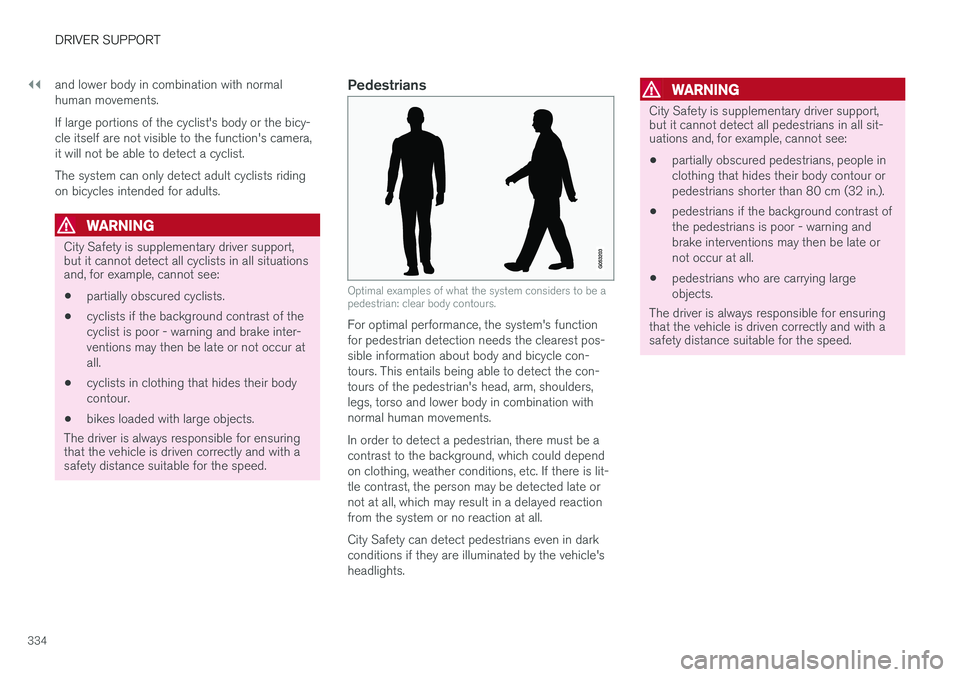
||
DRIVER SUPPORT
334and lower body in combination with normal human movements. If large portions of the cyclist's body or the bicy- cle itself are not visible to the function's camera,it will not be able to detect a cyclist. The system can only detect adult cyclists riding on bicycles intended for adults.
WARNING
City Safety is supplementary driver support, but it cannot detect all cyclists in all situationsand, for example, cannot see:
• partially obscured cyclists.
• cyclists if the background contrast of the cyclist is poor - warning and brake inter-ventions may then be late or not occur atall.
• cyclists in clothing that hides their bodycontour.
• bikes loaded with large objects.
The driver is always responsible for ensuring that the vehicle is driven correctly and with asafety distance suitable for the speed.
Pedestrians
Optimal examples of what the system considers to be a pedestrian: clear body contours.
For optimal performance, the system's function for pedestrian detection needs the clearest pos-sible information about body and bicycle con-tours. This entails being able to detect the con-tours of the pedestrian's head, arm, shoulders,legs, torso and lower body in combination withnormal human movements. In order to detect a pedestrian, there must be a contrast to the background, which could dependon clothing, weather conditions, etc. If there is lit-tle contrast, the person may be detected late ornot at all, which may result in a delayed reactionfrom the system or no reaction at all. City Safety can detect pedestrians even in dark conditions if they are illuminated by the vehicle'sheadlights.
WARNING
City Safety is supplementary driver support, but it cannot detect all pedestrians in all sit-uations and, for example, cannot see:
• partially obscured pedestrians, people in clothing that hides their body contour orpedestrians shorter than 80 cm (32 in.).
• pedestrians if the background contrast ofthe pedestrians is poor - warning andbrake interventions may then be late ornot occur at all.
• pedestrians who are carrying largeobjects.
The driver is always responsible for ensuring
that the vehicle is driven correctly and with a safety distance suitable for the speed.
Page 337 of 662

DRIVER SUPPORT
}}
335
Large animals
Optimal examples of what City Safety would interpret as a large animal: stationary or moving slowly and with clearbody contours.
For optimal performance, the system's function for detecting large animals (e.g. moose, horses,etc.) needs the clearest possible informationabout body contours. This entails being able todetect the animal straight from the side in combi-nation with normal movements for that animal. If parts of the animal's body are not visible to the function's camera, the system will not be able todetect the animal. City Safety can detect large animals even in dark conditions if they are illuminated by the vehicle'sheadlights.
WARNING
City Safety is supplementary driver support, but it cannot detect all large animals in all sit-uations and, for example, cannot see:
• partially obscured larger animals.
• larger animals seen from the front or from behind.
• running or fast moving larger animals.
• larger animals if the contrast of the ani-mal's background is poor - warning andbrake interventions may then occur lateor not at all.
• smaller animals such as cats and dogs.
The driver is always responsible for ensuring that the vehicle is driven correctly and with asafety distance suitable for the speed.
Related information
• City Safety
™ (p. 329)
City Safety in crossing traffic
City Safety can assist the driver when turning in the path of an oncoming vehicle in an intersec-tion.
: Sector in which City Safety can detect an oncoming
vehicle in crossing traffic.
In order for City Safety to detect an oncoming vehicle in situations where there is a risk of a col-lision, that vehicle must be within the sector inwhich City Safety can analyze the situation. The following criteria must also be met:
• your vehicle's speed must be at least 4 km/h (3 mph)
• your vehicle must be making a left turn
• the oncoming vehicle's headlights must beon